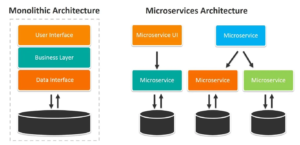In the ever-evolving world of web development, cloud computing has emerged as a game-changer. By offering scalable, flexible, and cost-effective solutions, cloud computing is transforming how websites and web applications are built, deployed, and managed. From startups to large enterprises, businesses are leveraging the power of the cloud to enhance their web development processes and deliver superior user experiences.
As we move further into 2025, the role of cloud computing in web development continues to grow, offering new possibilities for innovation and efficiency. In this article, we’ll explore how cloud computing is shaping modern web development, its key benefits, and why businesses should embrace this technology.
What is Cloud Computing?
Cloud computing refers to the delivery of computing services—such as storage, processing, and networking—over the internet (the cloud). Instead of relying on local servers or personal devices, cloud computing allows users to access resources on-demand from remote data centers.
Key features of cloud computing include:
- Scalability: Resources can be scaled up or down based on demand.
- Flexibility: Users can access services from anywhere with an internet connection.
- Cost-Effectiveness: Pay-as-you-go models reduce upfront costs.
- Reliability: Cloud providers offer high availability and disaster recovery options.
How Cloud Computing is Transforming Web Development
1. Scalability and Flexibility
One of the most significant benefits of cloud computing is scalability. Web developers can easily scale resources up or down based on traffic and demand, ensuring optimal performance without over-provisioning.
- Elasticity: Cloud platforms like AWS and Google Cloud offer auto-scaling features that automatically adjust resources based on traffic spikes.
- Flexibility: Developers can choose from a wide range of services and tools to build and deploy web applications.
Example:
An e-commerce website can scale its resources during holiday sales to handle increased traffic, then scale back down during off-peak periods.
2. Cost-Effectiveness
Cloud computing eliminates the need for expensive hardware and infrastructure, reducing upfront costs. Businesses pay only for the resources they use, making it a cost-effective solution for web development.
- Pay-As-You-Go: Cloud providers offer pay-as-you-go pricing models, allowing businesses to manage costs effectively.
- Reduced Maintenance: Cloud providers handle hardware maintenance, updates, and security, reducing the burden on businesses.
Example:
A startup can use cloud services to build and deploy a web application without investing in physical servers or IT infrastructure.
3. Faster Development and Deployment
Cloud computing accelerates the web development process by providing ready-to-use tools and services. Developers can quickly set up environments, test applications, and deploy updates.
- DevOps Integration: Cloud platforms support DevOps practices, enabling continuous integration and continuous deployment (CI/CD).
- Pre-Built Services: Cloud providers offer pre-built services like databases, machine learning APIs, and content delivery networks (CDNs), reducing development time.
Example:
A development team can use AWS Lambda to deploy serverless functions, reducing the time and effort required to manage servers.
4. Enhanced Collaboration
Cloud computing enables seamless collaboration among development teams, regardless of their location. Team members can access and work on the same resources in real-time.
- Version Control: Cloud-based version control systems like GitHub and GitLab facilitate collaboration and code management.
- Shared Environments: Developers can share development and testing environments, ensuring consistency and reducing conflicts.
Example:
A distributed team can use Google Workspace to collaborate on documents, share code, and communicate in real-time.
5. Improved Performance and Reliability
Cloud computing offers high-performance infrastructure and global data centers, ensuring fast and reliable web applications.
- Content Delivery Networks (CDNs): CDNs distribute content across multiple servers worldwide, reducing latency and improving load times.
- High Availability: Cloud providers offer redundant systems and failover mechanisms, ensuring high availability and uptime.
Example:
A media streaming website can use a CDN to deliver high-quality video content to users around the world with minimal buffering.
6. Security and Compliance
Cloud providers invest heavily in security, offering robust measures to protect data and applications. They also comply with industry standards and regulations, ensuring data privacy and security.
- Data Encryption: Cloud platforms encrypt data at rest and in transit, protecting it from unauthorized access.
- Compliance: Cloud providers comply with regulations like GDPR, HIPAA, and PCI DSS, helping businesses meet legal requirements.
Example:
A healthcare website can use Microsoft Azure to store and process patient data securely, ensuring compliance with HIPAA regulations.
Key Cloud Computing Services for Web Development
1. Infrastructure as a Service (IaaS)
IaaS provides virtualized computing resources over the internet, such as virtual machines, storage, and networking.
- Examples: Amazon EC2, Google Compute Engine, Microsoft Azure Virtual Machines.
2. Platform as a Service (PaaS)
PaaS offers a platform for developing, testing, and deploying web applications, including tools and frameworks.
- Examples: Google App Engine, Heroku, Microsoft Azure App Service.
3. Software as a Service (SaaS)
SaaS delivers software applications over the internet, eliminating the need for installation and maintenance.
- Examples: Google Workspace, Salesforce, Slack.
4. Serverless Computing
Serverless computing allows developers to run code without managing servers, scaling automatically based on demand.
- Examples: AWS Lambda, Google Cloud Functions, Azure Functions.

How to Get Started with Cloud Computing in Web Development
1. Choose a Cloud Provider
Select a cloud provider that meets your needs. Popular options include:
- Amazon Web Services (AWS): Offers a wide range of services and global infrastructure.
- Google Cloud Platform (GCP): Known for its data analytics and machine learning capabilities.
- Microsoft Azure: Ideal for enterprises with existing Microsoft products.
2. Define Your Requirements
Identify your web development needs, such as storage, processing power, and scalability. Choose services that align with your goals.
3. Develop and Deploy
Use cloud-based tools and services to develop, test, and deploy your web application. Leverage DevOps practices for continuous integration and deployment.
4. Monitor and Optimize
Regularly monitor your application’s performance and optimize resources to ensure cost-effectiveness and reliability.
Real-World Examples of Cloud Computing in Web Development
1. Netflix
Netflix uses AWS to stream content to millions of users worldwide. The cloud’s scalability and reliability ensure smooth streaming even during peak demand.
2. Airbnb
Airbnb relies on Amazon EC2 and S3 to handle its global platform, ensuring fast and reliable access for users.
3. Spotify
Spotify uses Google Cloud to store and process vast amounts of data, enabling personalized music recommendations and seamless streaming.
Conclusion
Cloud computing is revolutionizing modern web development by offering scalable, flexible, and cost-effective solutions. From faster development and deployment to enhanced collaboration and security, the benefits of cloud computing are undeniable.
As we move further into 2025, the adoption of cloud computing in web development is expected to grow, creating new opportunities for innovation and efficiency. By embracing cloud computing, businesses can build high-performance, reliable, and secure web applications that meet the demands of today’s digital landscape.
Read More: The Role of Low-Code and No-Code Platforms in Modern Web Development
High-Authority External Links:
- AWS Web Development Guide – A resource for building and deploying web applications on AWS.
- Google Cloud Web Development – A guide to using Google Cloud for web development.





